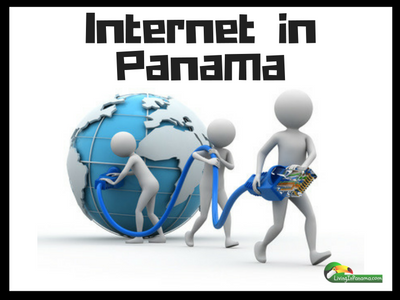
I'm not saying that internet in Panama will not be without its frustrations. It may stop for no apparent reason, you may pull your hair out while talking to, or trying to talk to, customer service, and then of course, the internet may be working fine, but you wouldn't know it because the electricity it out.
However, as you'd imagine, I use the internet all the time in Panama. Overall, while it is not lightening fast, it is more than adequate.
If you are in or near a city or town, it will be fairly easy to get internet. The more remote your location the harder it will be.
In the more developed parts of the country, like Panama City area, Colon and David, you will find high speed (for Panama) broadband cable internet and DSL.
In undeveloped, or older areas, then most likely you will be left with DSL as your fastest option. DSL can be fast, but its speed can fluctuate. In remote areas, the only option is satellite internet. Satellite internet can be very fast, but is more expensive.
At one time, the only Internet provider was Cable & Wireless. But since 2003 when the government opened up telecommunications to competition there have been a growing number of providers.
I asked a friend of ours to share her experiences with various internet companies in Panama. Specifically, in Puerto Armuelles, Panama. She has tried a few providers, while I have only used Cable & Wireless.
Our friend prefers to stay anonymous. I have edited her words slightly for clarity and added sub-headers.
Here is her experience with Internet in Panama.
I have used several Internet providers during my time in Puerto Armuelles.
Internet Activo
Currently I have Internet Activo and have been very satisfied with them and their service.
The only down side is they currently do not offer automatic deduction from a credit card for payment. So, I pay them every three months when I go to David. The other option would be to pay at one of the two banks where they offer a payment service of making the deposit and then providing proof of deposit.(Both banks are in Bugaba. But if I drive that far, I don’t see any sense in not just making a David run of it)
Planet Telecom
Planet Telecom was a personal nightmare for me on so many levels. They promised installation and equipment in a week – it took a month. I was at Andrea’s (an Internet place in downtown Puerto) for hours every day. (They knew not to set the timer on my computer!!) That was a pain because at the time I did not have my truck here.
When I was building my house, I wanted Plant Telecome to pre-wire my house. They sent someone out, finally, to do the pre-wiring. Because I had made an inquiry about the possibility of TV, as well as internet, they just assumed I wanted TV and installed that wiring as well.
I was charged for both the internet wiring and the TV wiring, as well as the travel and time to do the installation. The reality was that they were doing such a poor job that my worker, Jonathan, actually ran the wires! That is when I decided I would no longer do business with Planet Telecom!
Fidanque
I moved into my house and initially had Internet a company that is now called Fidanque. They were very good until they weren’t. I did like that they would automatically deduct the payment from the credit card I provided.
When they started the road expansion project, my Internet service was completely disrupted. I believe it was from interference from all the communications systems the road workers were using. At any rate they never could get the whole signal thing worked out so I had to move on.
Internet Activo (again)
Enter Internet Activo. They had no qualms about putting up an antenna that was high enough to block out the interference from the lower level interference. They are courteous, prompt, speak English and understand my payment schedule. I have been asking them to open a small account at Banco National, but so far no luck. I will ask them again when I go make the next 3 month payment. For some reason they believe that there is a $10,000.00 fee to set up automatic deductions from credit cards. There very well may be; I simply have no expertise in that area.
Cable Onda
Cable Onda has an excellent product and I had them for about a minute. (I still have their equipment on my roof).
The guy who signed me up spoke English. The guys who installed did not. After about a week, when I ran into a signal issue, I was dead in the water. No one anywhere in the company could speak English.
Right now, I am waiting for Cable Onda to finish laying all their fiber optic cable and will then I will switch over to them for phone and internet. They do have the best price – about $23.00 for 3meg of internet. Don’t know what it will be with telephone, but don’t think it will be that much more. They started marking their presence with a “deal” on satellite TV (all the blue dishes) so they would have some sort of customer base when they get the fiber optics done.
Cable & Wireless
Cable and Wireless has recently been bought out by someone else. They are unable to deliver 3 meg to Corazon de Jesus even though they say they can when they sign you up (enough theys for ya). Alexandra has them at her house – phone and internet – and the service is reasonably reliable. When there is an issue the repair guy is fairly prompt. They do have English speakers in their call center now so that does help with problems.
Internet Sticks or Dongle
I even tried one of those dongles and it was OK for checking email, but only while I was in the rental house. It never did work once I moved into my house.
(Note: you can buy these internet sticks, or traveling hotspots, from most internet and cell phone providers such as Claro and Movistar. They cost about $15 and the speed is slow. They can be useful for checking email and such in places without any internet.)
That is my Internet saga.
In another post, I (Betsy) will share my Cable & Wireless saga.
In May 2016, Cable & Wireless was purchased by Liberty Global. Hopefully, it will improve. Liberty Global is an American company, is in 30 countries and is the world's largest international TV and broadband company.
Here are some things to think about before choosing an Internet provider.
I would take their answers to these questions with a grain of salt, but it could give you a good indication of what it will be like to deal with them.
Important: Remember to check your Internet speed to ensure you are not paying for more than you are getting. Immediately downgrade so that you are paying for the speed you are getting, not the speed they promise you will get.
Updated March 16, 2017
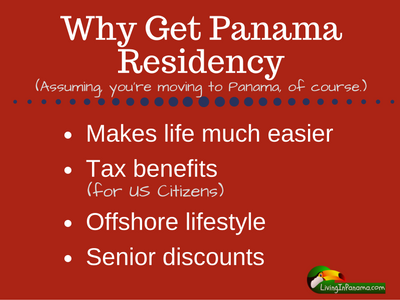
Americans may have more reasons to get a Panama residency than other foreigners, but every nationality benefits. (Scroll down for 3 American specific reasons)
As I said, a cedula is a Panama ID card. You can only apply for a cedula, after you become a Panama resident.
A cedula is forever. It is a document with a number specific to you. Like your social security number, it never changes.
Without a cedula, anything you do: getting a bank account, electricity, buying land, or even registering your car is done using your passport number. Unfortunately, every time you renew your passport you get a new passport number as well. Changing the passport number you have associated with almost everything in Panama is a nightmare and takes time.
More Cedula Perks
Get even more details about Panama cedulas in one of my older posts.
If you’re an American, you may have even more reasons to want be a Panama resident.
3 Reasons To Consider
Learn more about 4 types of Panama Residency Visas on my site.
March 2017 UPDATE: New Tourist visa rules make it impossible to be a Permanent Tourist in Panama. You must leave the country for at least 30 days before you can get another tourist visa.
Until March 6, 2017, many people lived in Panama as tourists for many years. But no longer!
You will need many documents to get residency: an FBI report, finger prints, birth certificates, medical examination reports, affidavits and more. It all must be certified, authenticated, notarized, stamped and gathered together and submitted, in person, in your presence. And some of those documents, like your FBI report, can expire and need to be done again if too much time passes before you are able to submit it.
There are 8 or 9 Panama residence visas. As I mention above, I have written about the 4 most common types of Panama residency visas.
You may want to hold off on getting your residency visa until you are sure you want to live in Panama on a long-term basis. The tourist visa gives you 180 days to check out Panama as you decide if it is a good fit.
Please let us know if we forgot to mention some of the benefits of having residency. Please comment below.
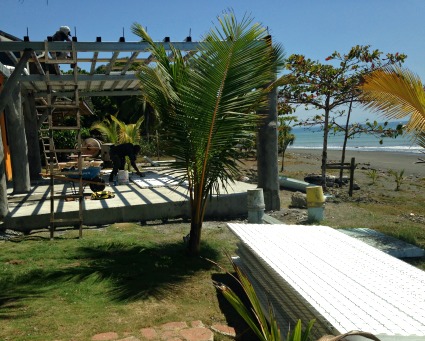
Given that, I was surprised that one of my favorite things to do as we traveled around Panama was to stop by construction sites and talk with other builders. I had fled the hustle and bustle of the building trade in Seattle only to discover, once again, how much I enjoy the fundamental beauty of human “dwellings” and how they are built. Apparently I made a good choice when I chose to become a designer/builder.
It doesn’t take long for one builder, chatting with another builder, in a new area, before the conversation winds its way around to the cost of materials, the cost of labor, the cost of land, to arrive at the potential profitability of being a builder in this new location.
Although I always prided myself on being more of an artisan design/builder than just a financially-motivated contractor, the profit potential in Panama is very seductive.
Early in our Panama travels we met a young builder and his girlfriend at Playa Cambutal. Playa Cambutal is out on the Azuero Peninsula, past Pedasi and Tonosi. They were both surfers and they loved this beautiful surf spot. The young man had borrowed $30,000 (as I recall) from his father who was a realtor somewhere in California. With this money, he and his girlfriend were able to buy a number of oceanfront farms, totaling over 2 miles of beachfront. Amazing!
We all know stories like this, and at first glance, one might say, “Wow! You guys are lucky. I guess we got here too late.” I remember my Dad telling stories about the farm he could have bought in Northern Virginia, a farm that later became Tyson’s Corner Mall.
There have always been great deals. And there will always be great deals. And we are all going to die some day. We still see amazing land deals in Panama.
About 10 years ago we spent some time investigating Pedasi and Tonosi, and other nearby locations. Yes, we discovered some amazing land deals. However, we decided that we were not interested in living so remotely, so far from services. And we had no interest in traveling to check in on any land we would buy in such a remote location.
This young couple (above) explained to us that they had to spend several hours, twice a week, driving to a small town, about 40 miles away, to do their basic shopping. For our own family, spending so many hours on the road, just sitting in the car, and burning gasoline, would not have fit our desired lifestyle. This was the in-the-car lifestyle we were trying to avoid by moving from Seattle. So we left the Azuero Peninsula and chose to live and invest in Puerto Armuelles. If you have read our site much, you will know we are very happy with our decision.
When I am asked if there are any “deals” left in Puerto Armuelles, I have to chuckle.
In truth, the big speculator class of investors arrived in Puerto 12 or 13 years ago. We got here 3 years after the miles of beachfront were sold to speculators from out of town. These same early investors continue to sit on some of the largest tracts of beachfront property in our area. I have no idea how they spend their days. But I am sure that they hardly ever think about our little beach town, unless they are looking at their investment portfolios.
A couple of these “big fish” are now offering schematic drawings of their future plans for these properties, but they haven't started to build yet. Or seemingly will in the near future. Meanwhile, a smaller class of builders, folks like us, is beginning to develop and build.
Yes, there are deals still to be had here. But you will not find the best deals advertised on the internet. You will find them by being here in Puerto.
You need to look around. Decide on your favorite locations and start talking with people. You will start to hear about some stellar deals.
For instance, if you shop, you can still pick up a house, a block from the water, for only $11,000 and a buildable lot for as low as 3 to $5,000.
Puerto Armuelles is a beach town of 25,000 residents, give or take.
It has many good properties and existing buildings, that with a skillful touch can still be resold for a substantial profit.
We want to encourage designers and builders to come check out Puerto Armuelles. To discover if there are any potential projects that suit them in our town. If so, not only will you have a great project, but you can step out of the stressful lifestyle of being a builder, contractor, or designer up north.
If you have experience in alternative energy housing, cooling, and transportation, even better. That is an untapped market here.
There is plenty of room for competitors in our market. Puerto Armuelles does have a few good builders, but we definitely need more motivated and skilled investor builders to provide housing for the growing influx of expat retirees. More good builders will just bring a greater diversity of expats and Panamanians to enjoy the lifestyle that Puerto has to offer.
Small-scale projects are definitely in demand. We recently sold a couple of our own projects. We did not make ten, or even five times our initial investment, but we have done well enough to carry us forward. Plus we have had a good family adventure and enjoyed our time doing it. And we have also slowly evolved our guiding design principles for building in our area. We are eager to continue to buy, to build and to sell.
We are excited by the uptick in the housing sales market. This enables us and others to design and build in a manner that inspires us, and that we think will be useful to new expat residents of Puerto Armuelles.
Our friend Victor describes life in Puerto Armuelles as being similar to that of Hawaii, or Southern California of 50 years ago.
You may find Puerto Armuelles is a more relaxed, and probably a more profitable building environment. And you won't have the stiff competition from other builders.
The broadest market niche by far available to expats in the construction field is that of “investor/builder”. You don't need a work permit to work on your own property, even if your intent is to sell it.
However, for the last few years, Panama has made getting a work permit much easier. This is especially true if you obtain the easy-to-get, Friendly Nations visa. That permanent resident visa was designed as a stepping stone to a work permit.
If you are a builder looking for a change in lifestyle, we invite you to check out our town.
For the builder who loves a beach town lifestyle, I would say that Puerto Armuelles is similar to Puerto Vallarta 50 years ago. It is a relaxed, maritime environment. And it probably won’t be like this forever.
Related Reading
You may be interested in reading my articles about building. I have given my 2 cents on
We have also written about these related items:
Updated Dec 13, 2019
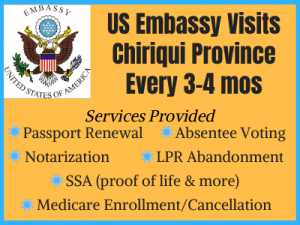
You can accomplish many tasks at one of these ACS travelling shows.
As I mentioned, the ACS visits David and/or Boquete every 3 to 4 months. If you are lucky, their visit will be in time to save you a trip to Panama City.
To find out when they will be in town, you can visit the embassy's website, email [email protected], or give them a call during their very limited phone-answering hours.
Unfortunately, the embassy doesn't set the date for ACS's visit to the Chiriqui province much in advance of it happening.
The ACS will only accept payment by local banker’s cashier check (known in Spanish as “Cheque Certificado”). That is, the check needs to be issued by a Panamanian bank. It must be made payable to “U.S. Embassy Panama” and have been issued within the past 5 months.
The ACS will NOT accept cash or credit card payments. The notarial fee is $50 per each signature of the Consular Officer.
Depending upon which ACS services you will be using, you will need to bring the following documents.
Passports: For adult passport renewals, in addition to the completed DS-82 application, provide one recent color photo with a white background that measures 5x5 cm (2X2 inches), your passport, and a photocopy of the photo page of your passport. The fee for an adult passport renewal is currently $110. If your previous passport was lost or stolen you will also need to bring a copy of the police report and the fee for the new passport is $135.
You will be happy to learn that you can complete adult passport renewals by mail (or Uno Express). You do not have to visit the embassy in person to renew.
For minor passport renewals, in addition to the completed DS-11 application, bring a copy of the photo page of the minor’s passport, a copy of both parents’ passports /cedulas, one recent color photo with a white background that measures 5x5 cm (2X2 inches) and a copy of the minor’s birth certificate, in addition to the original birth certificate and passport/ cedulas. The fee is currently $105.00 for a minor (under 16) passport renewal. The minor and both parents or guardians must appear in person. If only one parent is present in Panama, the “Statement of Consent from Absent Parent” Form DS-3053, notarized in the U.S., is required. Please note that the DS-3053 will not be accepted if notarized in Panama.
Notarizations: If you are requesting the notarization of your driver’s license, bring a photocopy of the front and back page of your license, as well as your license. If you are requesting notarization of benefits documents, bring the original and a copy of the document(s) showing the amount of benefits you receive monthly or annually. The notarial fee is $50.00 for each signature of the Consular Officer. Visit this US Embassy webpage to learn all the details regarding getting a document notarized there or at the visiting ACS unit.
Voting: You can submit your completed absentee ballot, no postage required, at the travelling ACS unit (or at the US Embassy in Panama City).
If you haven’t yet registered to vote or requested an absentee ballot, you can find out how to do those things by visiting the Federal Voting Assistance program's website. I also explain how US citizens can register and vote from Panama in this post: How To Vote in US Elections While In Panama.
LPR Abandonment: Bring completed form I-407 and a photocopy of your Permanent Resident Card, as well as your Permanent Resident Card. (Filling out this form means you decided to voluntarily abandon your status as a lawful permanent resident of the United States.)
The Embassy stresses that all your copies of the required documents, noted below, need to be legible.
SSA Proof of Life: If you are required to comply with this requirement, please bring your cedula or passport.
Medicare Enrollment/Cancellation: To enroll in Medicare, you should complete and sign form CMS 40B. To find out more about Medicare eligibility and how to cancel your participation, this US government Medicare page is a good place to start.
Social Security Replacement Card: Bring a copy of your valid U.S. passport and completed form SS-5FS.
Social Security Card for child under 12: Bring a copy of the U.S. passport for one of the parents, the child’s “copia integra” birth certificate, and the child’s U.S. passport (as well as copies) as well as completed form SS-5FS.
Change of Address for Social Security: Bring your current passport or cedula.
International Direct Deposit Enrollment: You should bring the necessary form and whatever other documents the form instructions requests. Before the ACS visit, e-mail the SSA Federal Benefits Unit ([email protected]) to request the enrollment form.
You can get more information on getting your Social Security checks directly deposited into your bank account (in the US or in Panama) on this US Embassy webpage.
If you live in Panama and have questions regarding Social Security, you must contact the SSA Federal Benefits Unit (FBU) located in Costa Rica. For more information on their services and how to contact them, please visit their webpage.
For comprehensive information on SSA’s services abroad, please visit SSA’s Service Around the World.
Also, I wrote a post about how to continue to receive SSA benefits while in Panama.
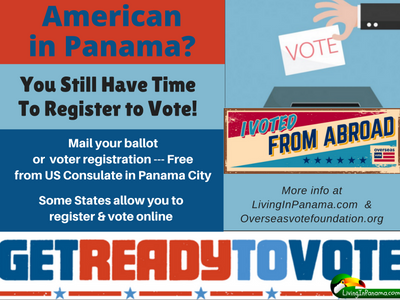
There are several websites that will help you both register to vote and vote. In many cases you can do these online. Some states allow voting by email or fax.
For resources on how to vote as an American overseas go here.
The US Consulate in Panama City has special postage paid envelopes available.
You can also create your own with a blank envelope and a printer. You can get the necessary information to print your own envelope from one of the online voter assistance websites for Americans living abroad. For instance, the Federal Overseas Assistance website has all the information you need for your envelope at this link.
Are you in the Chiriqui Province? The US Embassy is visiting David & Boquete on October 12th. You can hand in your absentee ballot during their visit. Don't have your absentee ballot yet? go here.
The US consulate is open only from 8 a.m. until noon. You don't need an appointment.
Take your envelope to Window 14 at the consulate.
The US Consulate is in the American Embassy complex in Clayton. You can visit the US Consulate in Panama's current voting information, by clicking here.
The US Consulate does not offer overnight mail. You should count on it taking 2 weeks for your ballot to reach its destination.
For the US Presidential election on Nov. 8th, the Consulate recommends that you get your ballot to them no later than Wednesday, October 26.
If it is less than 2 weeks from election day, you should overnight mail it using FedEx, DHL, or other service.
You also might want to contact your state election office to discover if you can fax or email it.
One or more of these sources for overseas voting should help you find out more about your options.
Please comment below
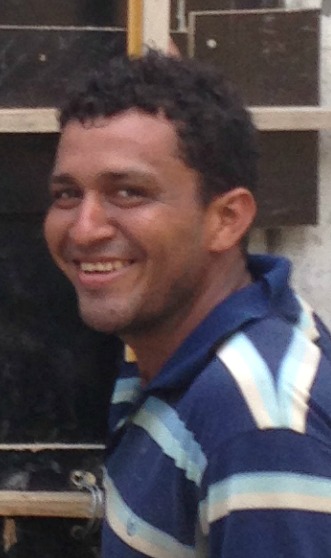
In fact, soon after our announcement our very first student began receiving one-on-one English conversation practice.
He appears to be advancing in his English speaking and listening proficiency at a very rapid rate. This student is highly motivated and also spends several hours each day listening to podcasts in English, as part of his self-created “English Immersion” program.
Obviously, we are still in the formulation phase of our project. We have no fixed structure in place. While we are still uncertain about the details, we are certain that there is a need for such a program. The best way to learn English is by being exposed to native English speakers.
If you are interested in participating in any way, please contact us.
Perhaps you have skills that could be useful to the program, even beyond simply tutoring in English. We are especially interested in talking with someone who is skillful in coordinating communication among the students and volunteers in the program. We are looking for volunteers to:
I am positive that I am not capable of all of the emails, texts, etc…that may be required, as the program gains momentum. However, I am available to participate in developing the process and introduce new tutors and students to the program. As the program grows, as I am sure it will, I may even be able to provide a physical space in Puerto Armuelles for holding classes, or one-on-one tutoring sessions.
Over the next year or so, it would be wonderful if we could offer English conversation opportunities to a 1 - 2 dozen motivated young people in Puerto Armuelles.
Hopefully, this program will help increase the English language proficiency in Puerto Armuelles. Fluency in English will certainly give these young people access to many opportunities in fast-developing Panama.
In recent months, we have talked with more expats who have plans to move to Panama, and Puerto Armuelles. Some of them already have a desire to help the young people of Puerto Armuelles. Many have also said they'd be interested in volunteering in the English tutoring program. Added to the longer-term expats in the area, we should be seeing a growing pool of potential volunteers.
Tutoring a young person from Puerto Armuelles in English is a great way to get involved in the community, in positive way, without making too big a commitment.
Not a Permanent Commitment
If you want want to volunteer, but don't want to commit, that is perfectly fine. You can assess as you go along. You can see if you would like to increase your participation, or back out if you discover you don't enjoy it. No worries or judgements. But for some expats, retiree or otherwise, this could be just the sort of adventure that they have been looking for.
An Exchange Program
We have also gotten requests for Spanish language lessons from local expats, particularly from retirees. For this reason, the idea of a “language exchange” program has emerged.
An exchange, or “intercambio” is a great way for an expat to share their own English language skills with a local youth. In exchange, the youth would help you to learn Spanish. This kind of program has been successful in many places. There is no reason that it couldn’t work for us here in Puerto Armuelles.
Please let us know if you are interested in participating in an intercambio.
Please let us know if you are interested or have any comments or suggestions.
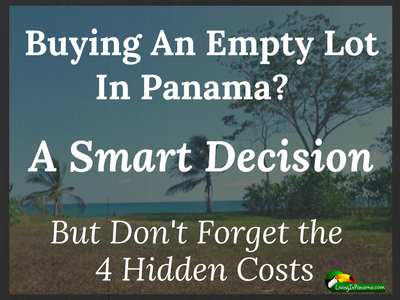
1) There is a lot of it. So there are many opportunities of buying the location you want at a price you can afford.
2) Vacant lots cost less. Somewhat surprisingly, even a lot with a structure that looks like it should be torn down, is priced higher than a similar lot with no structure. Check it out for yourself. There must be some psychological reason for this.
3) Investing in a vacant lot carries very low overhead costs---and there is usually very little maintenance required.
4) You get complete freedom to build & landscape the way you want. You decide where on the lot the house will be built, and what it will look like. You decide the look and feel of your property. If you have never gardened before, this is the place to get started. To cultivate many species, you simply get a cutting, stick it in the ground, and water. If you plant in the rainy season, you can skip the watering part. The term tropical paradise fits gardening perfectly here.
In Panama, you can buy a lot in the jungle with no infrastructure around --- not even a road --- or you might choose a lot in a sub-division, a place that has everything you need in place, ready and waiting for you to build your home.
More Remote = More Hidden Costs
Obviously, a lot that has everything ready to build your house will have no additional development costs. While a remote jungle lot could have very high development costs. Development costs are all the expenses necessary to get a site ready to start construction of a home.
Before you jump to the conclusion that an undeveloped lot is a screaming deal, you must factor in all the hidden costs. That is, how much will it really cost to get the property into “ready to build” condition.
The True Cost = Sales Price + 4 Hidden Cost Factors (described below)
You should calculate the true cost of a lot before you decide to buy. This is true even if you only plan to hold the property and sell it when it goes up in value. Most likely the person you eventually sell the property to will want to build on it. You need to make sure you are buying a lot that will be attractive and affordable to your future buyer.
Cost of the road or driveway will depend upon the lot’s
If you fall in love with a lot that is far from an access road, it will obviously cost a lot more to develop than if your lot is near, or on, an already established access road.
If the property is on a steep slope, that will open up whole new realm of hidden costs. Not only will the road cost a lot more and take more time, but you will have to deal with erosion and drainage issues. In a hilly area, you must take care to consider what to do with the water runoff so your new road won't be come a mud disaster. One key to a successful road is to put it in the dry season, not the wet season. After all the work of creating the road, you want it to stay usable for years to come not be washed out in the next big rain.
If you want to keep your road development costs down, or at zero, you should pick a lot that is
Google Earth - A Real Estate Tool
With Google Earth you can discover topographically challenging lots from the comfort of your computer. And you can use it to get a feel for the property before you visit it. Google Earth is free and can be used with both Apple and PC computers. To use it, you need to download the software and then search for your property by using its address or coordinates.
Now comes the fun part. You can zoom in using your mouse/curser and the command (control for PCs) and shift keys on your keyboard. Using the same controls, you can tilt the earth so you can see precisely where all the hills and valleys are on the lot and in the surrounding area. If you don’t know the lot's coordinates or address, you can usually find them using Google Maps (if you can locate the lot by sight), or by asking the seller for them.
Now that you can access the lot, you need to get it ready for constructing a house.
Ideally, your site is already level. Or it could simply mean removing some trees (just make sure to get a permit to do that) or adding a moderate amount of fill to level out the site.
If you are building on a slope, it will be more complicated. You may need a major earth building project including retaining walls and or drainage system.
Make sure you get a good ideas of the cost of these steps or it may come as an unwelcome surprise.
If you want to keep your site development costs down, or at zero, you should pick a lot that is
We have many affordable and beautiful lots. Almost all of our lots are ready to be built upon. No site or road development is needed. Many already have full utilities, or we offer to do that work at no extra charge. All are in the Puerto Armuelles area.
You can explore our properties by clicking here or using the property search tool at the top of the page.
Now on to getting utilities to your building site.
Generally, there is electricity available along all of the main roadways and neighborhood streets in Panama.
In Remote Areas
If you are buying a farm, or other remote property, you will be responsible for bringing in electrical power from the nearest road, where you will access it via overhead power lines. You will need to install your own power poles, or underground conduit, to access this power. And of course, you will need a licensed electrician to obtain an electrical permit, even if you are going to do your own electrical installation.
Alternatively, you can always decide to be completely off-grid. Just be sure to factor in the full cost of setting up and maintaining your own electrical system. Of course, if your lot is extremely remote you will have to go off-grid.
In Developed Areas (e.g., Puerto Armuelles)
In Puerto Armuelles, we generally have good access to power lines by our electrical utility provider (Union Fenosa). This makes electrical installation simple.
Once you start to build your house, you can connect the meter to the house in 2 ways. You can either hang an overhead line, which enters through the roof of your home, or you can install underground conduit, with the supply wires running inside. These wires connect the breaker panel to the electrical meter at the property line. From the breaker panel, you can do your own rough in wiring, or hire an electrician.
You can live without electricity, but not water. How will you get water to your lot and future house.
In Remote Areas
Before you buy a property in a remote area, make sure you know how you will get water to the site. It is likely that you are going to have to dig a well. If it is a well, check with an engineer to verify that you can actually build a well. Find out how deep a well you will need to dig. Then calculate the cost. If you are told there is a well there already, I suggest you check this out and test the water.
About Digging Wells
The good news about well digging in the rural areas around and as well as in Puerto Armuelles, is that it is very cheap. In most cases, wells are dug by hand, using a shovel. Our soil is silty/sandy, and it has no aggregates. (This is why it is not the most stable building substrate, and building footings should be deep and use plenty of steel reinforcement).
In short, a laborer digs your well, and then you line it with concrete pipe sections which are available in 4 foot lengths, and in many diameters from 10" to 2 or 3 meters.
Please be aware, hand digging is dangerous for the laborer. You should check with the municipal engineer to find out the details for doing this safely and if the person doing the work is covered by insurance. You can make it safer by having the hole supported, or "cribbed" during the excavation.
The pipe sections used to line the well are very heavy. You will need to schedule a back hoe to have them installed. You might just opt to use a back hoe for the entire well digging process, however the result will be quite sloppy. Back hoes cut a very wide hole. All that dirt will need to be stored on site until it is back filled. The dirt excavated for the actual well hole will need to be stored or used permanently either on site, or off site.
And, of course, you can also employ a well drilling company. There are some located in David. Just look them up on the Internet. I have not used a well drilling company yet. Obviously, this is the most expensive well digging option.
In Developed Areas (e.g., Puerto Armuelles)
In Puerto Armuelles (and other developed areas), most locations have access to the municipal water supply.
Hooking Up Water
To gain access to the municipal water supply, you simply cut in a connecting hub, or collar, into the ABS water line that runs alongside the street nearest your lot. In Puerto Armuelles, this ABS pipe is likely to be 3" in diameter.
You can buy a connection collar at most of the local building supply stores in Puerto Armuelles. You will need a permit both for the water supply line hook up and for any necessary street cut for the new pipe. You will only need a street cut permit if the city water line happens to be located on the opposite side of the street from your property. This street cut is performed by MOP (Ministry of Public Works).
I am fairly certain that you can apply for your own permit. However, for the $20 that my plumber charges to do all the legwork of obtaining permits, I never get my own permits. At all costs, I try to avoid waiting in lines at all of the various municipal offices. I don't have the patience.
Service & Expense
Generally our water service is good. The water is abundant and cheap. Our bill is under $5.00/month for unlimited use.
Interruptions in Supply
Many locations in Panama, including Puerto Armuelles, still experience occasional water shortages. In our area, these are not actual shortages, but rather interruptions to service. Water service is temporally shutoff due to a highway building project, or occasionally, storm related damage to a water supply pipe during heavy rains. Such interruptions are becoming less and less frequent. This is certainly not a chronic problem anymore, not the way it was 10 years ago. In addition, the water to our neighborhood is shut off in the afternoon everyday. I have never been clear about exactly why this is done. But it is the reason almost every house in our neighborhood has its own water tank.
Install A Water Tank
It is never convenient to be without fresh water, even for a few hours. The easiest way to overcome this is to have your own water storage tank located on your property. That way, you won't even notice when the municipal water supply is shut down for an hour, or even an entire day. You will have your own backup supply on your property.
At our house in the Las Palmas neighborhood we have a 140 gallon emergency tank. It is raised up on a platform about 12 feet above ground. It fills whenever there is city water pressure. When the municipal water fails due to road work, which has been pretty common with the new highway construction, or due to the new water and sewer system being installed in Puerto, we are covered. We also use it everyday as the source of our water after the city water is mysteriously turned off for the day. We have a gravity feed from this elevated tank directly to the house---we don’t use a pump. It has been years, since we were absolutely “out of water”.
Water Drinkability
Generally, water is drinkable in Panama. Bocas del Toro is the only blanket exception to this rule. In addition, at times, Panama City has issues with its water quality.
But again, overall, Panama's water is perfectly drinkable. Much more so than some areas of the US (not even including Flint, Michigan). My daughter still reminds me of how truly horrible the water is in the elegant neighborhood of Washington D.C. where her grandparents live. My parents happily drink that water. They are used to it. My children considered it to be unfit for human consumption.
Although the water in our town is drinkable, most expats and many Panamanians filter or buy bottled water. Many people (like us) get bottled water delivered to their home. Some people are concerned about water quality, but many people do it for aesthetic reasons. In the rainiest times of the rainy season, the water from the tap can look cloudy. That is what prompted us to start drinking bottled water. We always use tap water for cooking, but for drinking we use bottled water. At least we do at home, when we go out we happily drink the tap water.
You must include the cost of taking care of all the outflow from your home as well. How you take care of this depends upon where your lot is located.
Out of Town & Remote Areas
Sewer service is only available right in town, or along the main roads. If you are not in town, or on a main road, you will need to invest in a septic tank.
You are supposed to get a permit for most plumbing projects, including a septic tank. This application must be submitted by a licensed plumber, even if this plumber is not going to do the work. Talk to your neighbors to learn more about how this septic tank permit & installation process is usually done in your area.
Installation of Septic Tanks
There are a variety of methods for installing a septic system. The very poorest people in Puerto Armuelles simply dig a deep well, line it with old car tires, and run their pvc waste line into it (or put an outhouse on top).
Most locals who can afford it, build 2 separate septic tanks out of concrete block.
The 1st one, in line from the house, captures the solids and lets the liquid flow off the top toward a secondary tank. This 2nd tank is filled with large round drainage rock. (This rock is available from local rivers. It can be delivered to your building site by local truck operators.)
This 2nd tank provides a drainage “field” which leaches out into the surrounding soil, and hopefully, filters out all dangerous bacteria, before flowing to a nearby stream, or the ocean.
You can also purchase black plastic (ABS) molded tanks from local building materials suppliers, or from suppliers in David. Most suppliers in David offer delivery services to Puerto.
In Town - Sewer Connection
If your lot is in town, or off a major road, you can hook up to the municipal sewer system. To connect to the municipal sewer pipe on your street, again, you must apply for a permit. Again, this application must be filed for by a licensed plumber, even if this plumber is not going to do the work.
The connection is a simple matter of cutting in a connecting hub to the municipal sewer line, usually 6” pvc pipe. Generally, homeowners connect their own 4” pvc pipe to this 6” pvc pipe. It is a simple procedure. Pipes are not buried very deeply. Generally not over 3 or 4 feet. Given that our soil is silty/sandy, this kind of work can usually done with a couple of laborers with hand shovels in half a day.
The entire connection process, including plumbing and backfill, shouldn’t take more than a day. That is, after you have the permit in hand.
Before you buy a lot, you should estimate the cost of permits, materials, and labor to get utilities to your building site.
Obviously, if all your utilities are already delivered to your lot, you will be saving both money and headaches. If your lot is in a remote area, your "get your site ready" development costs will be a significant part of the true cost of your lot. Also, don't forget to factor in the amount of time it will take to get all that infrastructure into place.
The bottom line: Is the lot worth the price?
To know that, you first need to know the true cost of the lot. True price = Sales Price + 4 Hidden Cost Factors
Which Is The Better Buy?
Calculating the true price eliminates many unexpected expenses. It also allows you to knowledgeably compare seemingly diverse properties. For example, knowing the true cost of properties allows you to know which of these similarly sized and located lots is a better buy:
Hopefully, you now have a better understanding of what it means to buy an empty lot. As we explained, depending upon the lots location, getting an empty lot ready to build upon can be very easy or very challenging process.
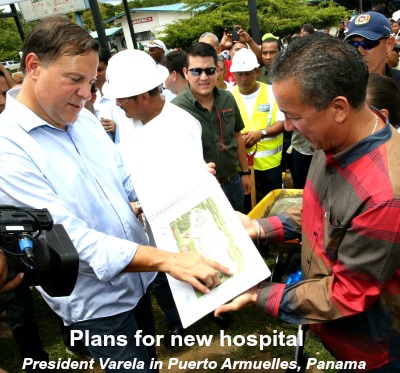
Thurs, September 8, 2016
A crowd of Portenos had assembled to hear him speak.
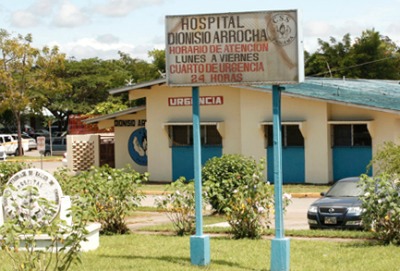
Puerto Armuelles will have an all new hospital. The new facility will include:
It will happen in 3 phases.
But while the new hospital project is a positive backdrop for President Varela’s visit, the crowd gathered were more interested in knowing:
“What are you going to do to boost our local economy here in Puerto Armuelles?”
Residents of Puerto Armuelles are somewhat skeptical of the promises of President Varela, as they were of previous presidents. After Chiquita Banana left Puerto Armuelles, now about 15 years ago, presidential administrations have all promised projects to bring economic vitality to Puerto Armuelles.
Today, President Varela explained that he is fulfilling his promises to Puerto Armuelles residents.
First of all, the current negotiations with Del Monte to take over the Chiquita Banana plantations are almost complete. (These negotiations have been in process for over a year.) The President has signed the final executive approval for Del Monte to begin work. All that remains is the final approval by the legislature. (Find out more about the Del Monte banana deal here).
President Varela anticipates that the deal will be passed by the legislature in the near future. He predicts that Del Monte will start operations in early 2017.
The Panama government has negotiated with a few other banana companies (including Chiquita) since Chiquita left Puerto. But none, have gotten as far into the process as Del Monte.
Del Monte will employ up to 3,000 workers in Puerto Armuelles.
I'm sure Del Monte taking over the banana plantations will contribute to the current upswing in prosperity in Puerto Armuelles. The renaissance of the “Green Gold” can only be good for Puerto. (Green Gold was the a name used for bananas during Chiquita's reign of Puerto Armuelles.)
In addition to President Varela’s announcement about the imminent arrival of Del Monte, the president also touched on the continued investment in the new, 4 lane highway into Puerto Armuelles.
Road out to Limones
Varela stated that he had approved the funds to continue this new highway all the way out to the fishing community of Limones. Limones is 12 kilometers past Puerto Armuelles, on the Punta Burica Peninsula.
Over the last decade, the road to Limones has been upgraded several times. But the work has always fallen short of a long lasting and paved road. All past work on the road, has been partial at best and it has always fallen into disrepair very quickly.
This time, President Varela said, the work is going to be done right.
The President stated that, with these and other positive investments, the Puerto Armuelles community will continue to reap the benefits of the higher quality of life so much of Panama is enjoying.
[leadplayer_vid id="57C322E278CDC"]
Sometime I will remember to take a video when the thunder and lightening really gets going.
It can get very loud. And the lightening here flashes and spans the sky in ways I have not seen anywhere else.
Until late in August, it was not raining everyday. And when it rained it was typically raining for 1 to 2 hours in the afternoon.
But as we head into September, the rain is sometimes invading the morning hours.
Sometimes in November we can have days of rain.
If you are interested, I written more extensively about the rainy season and the overall climate in Panama.
For more on living in Panama, check out our blog and our frequently asked questions about Panama.